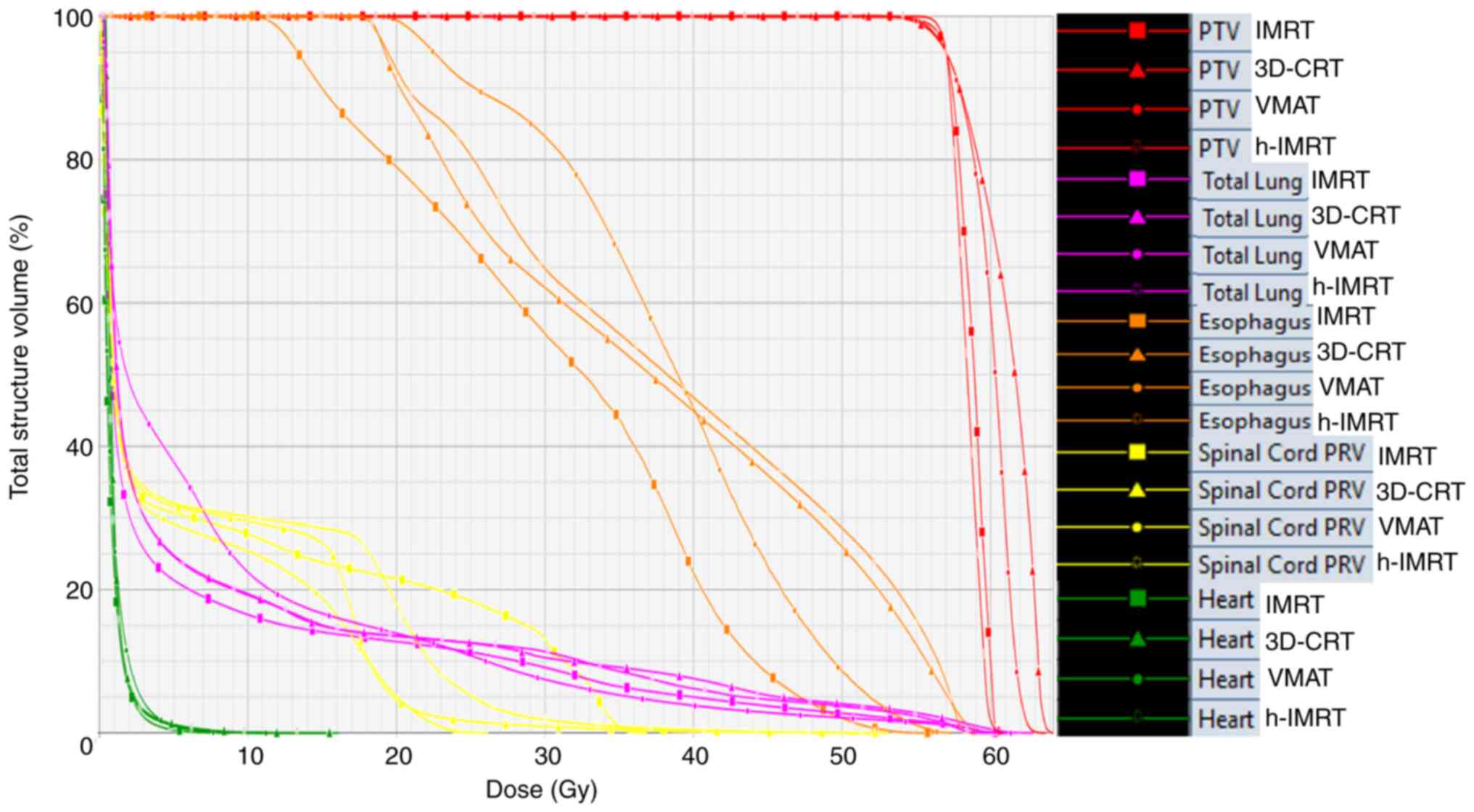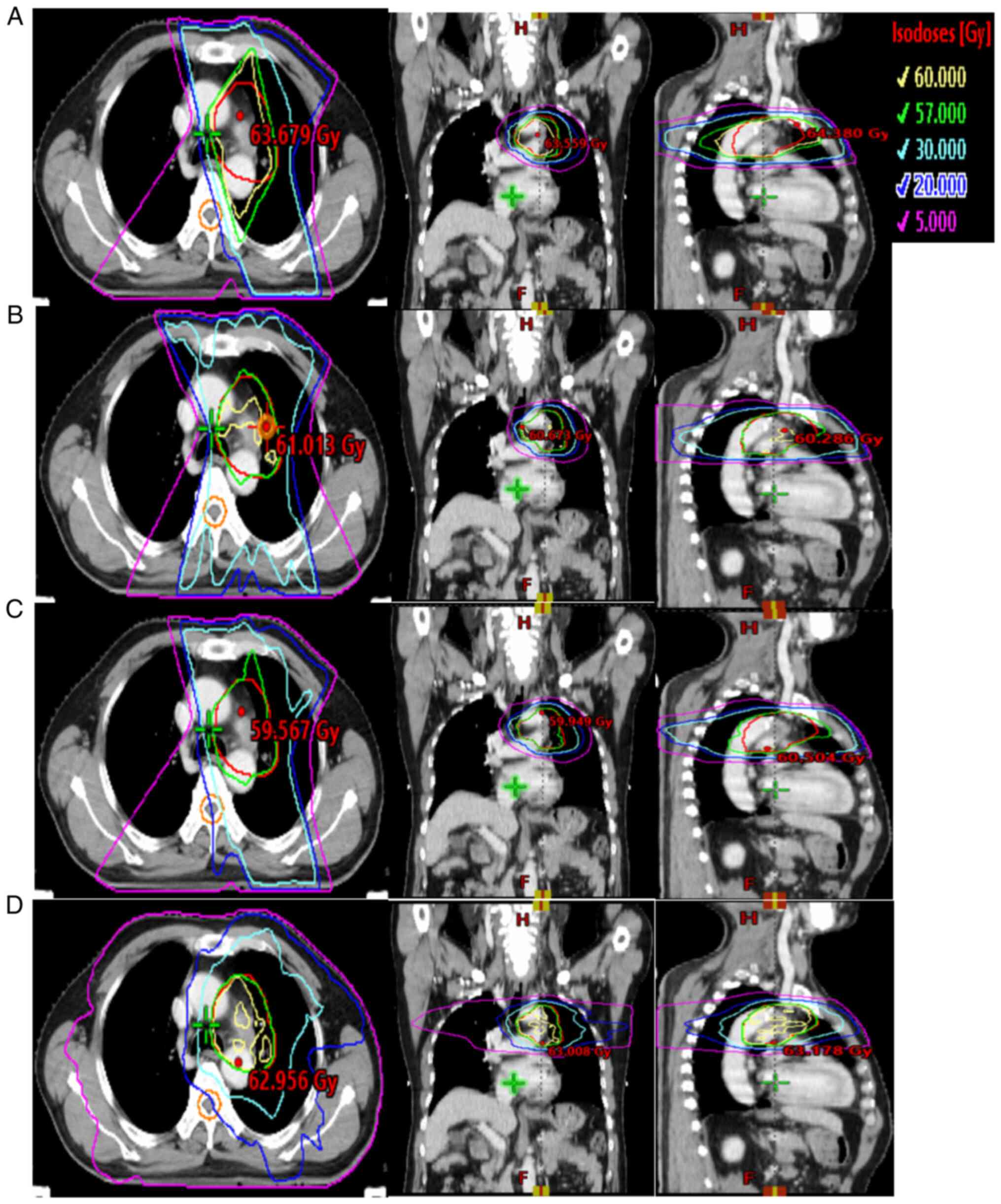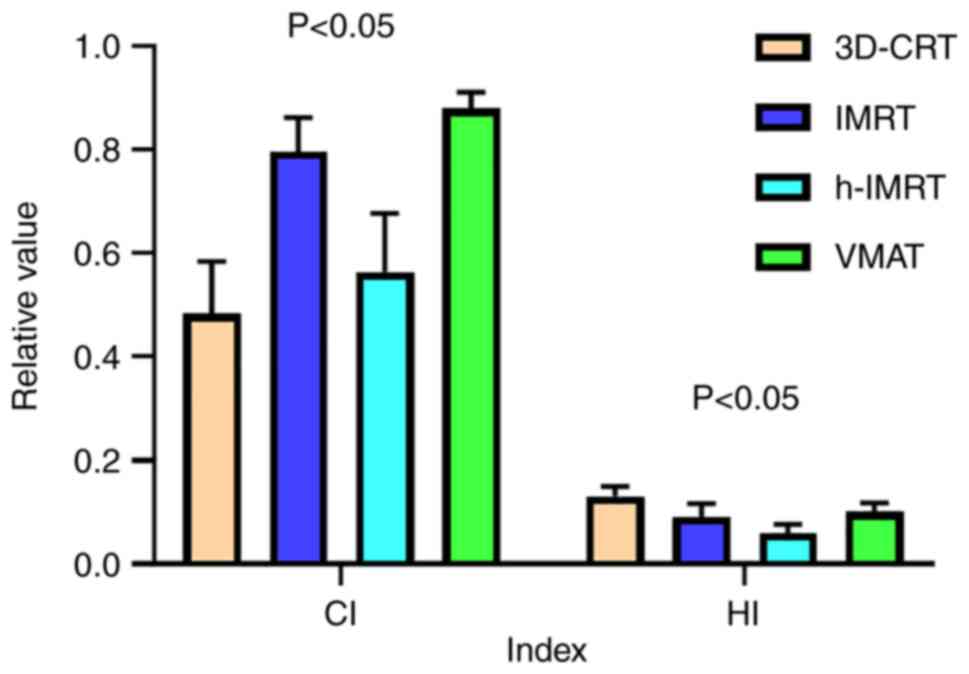|
1
|
Sung H, Ferlay J, Siegel RL, Laversanne M,
Soerjomataram I, Jemal A and Bray F: Global cancer statistics 2020:
GLOBOCAN estimates of incidence and mortality worldwide for 36
cancers in 185 countries. CA Cancer J Clin. 71:209–249. 2021.
View Article : Google Scholar : PubMed/NCBI
|
|
2
|
Conibear J; AstraZeneca UK Limited, :
Rationale for concurrent chemoradiotherapy for patients with stage
III non-small-cell lung cancer. Br J Cancer. 123 (Suppl 1):S10–S17.
2020. View Article : Google Scholar
|
|
3
|
Punnett G, Fenemore J, Blackhall F and
Yorke J: Support and information needs for patients with non-small
cell lung cancer receiving concurrent chemo-radiotherapy treatment
with curative intent: Findings from a qualitative study. Eur J
Oncol Nurs. 64:1023252023. View Article : Google Scholar : PubMed/NCBI
|
|
4
|
Kao J, Farrugia MK, Frontario S, Zucker A,
Copel E, Loscalzo J, Sangal A, Darakchiev B, Singh A and Missios S:
Association of radiation dose intensity with overall survival in
patients with distant metastases. Cancer Med. 10:7934–7942. 2021.
View Article : Google Scholar : PubMed/NCBI
|
|
5
|
Alterio D, Gugliandolo SG, Augugliaro M,
Marvaso G, Gandini S, Bellerba F, Russell-Edu SW, Simone ID,
Cinquini M, Starzyńska A, et al: IMRT versus 2D/3D conformal RT in
oropharyngeal cancer: A review of the literature and meta-analysis.
Oral Dis. 27:1644–1653. 2021. View Article : Google Scholar : PubMed/NCBI
|
|
6
|
Faye MD and Alfieri J: Advances in
radiation oncology for the treatment of cervical cancer. Curr
Oncol. 29:928–944. 2022. View Article : Google Scholar : PubMed/NCBI
|
|
7
|
Xu Y, Deng W, Yang S, Li P, Kong Y, Tian
Y, Liao Z and Chen M: Dosimetric comparison of the helical
tomotherapy, volumetric-modulated arc therapy and fixed-field
intensity-modulated radiotherapy for stage IIB-IIIB non-small cell
lung cancer. Sci Rep. 7:148632017. View Article : Google Scholar : PubMed/NCBI
|
|
8
|
Zhang Y, Han A, Fu Z, Xu S and Zhang Z:
The dosimetric comparisons of CRT, IMRT, ARC, CRT+IMRT, and CRT+ARC
of postoperative radiotherapy in IIIA-N2 stage non-small-cell lung
cancer patients. Biomed Res Int. 2019:89892412019.PubMed/NCBI
|
|
9
|
Shrimali R, Chakraborty S, Bhattacharyya
T, Mallick I, Achari RB, Prasath S, Arun B, Mahata A, Shree MV,
Vishnupriya E and Chatterjee S: Development and validation of a
decision support tool to select IMRT as radiotherapy treatment
planning modality for patients with locoregionally advanced
non-small cell lung cancers (NSCLC). Br J Radiol. 92:201804312019.
View Article : Google Scholar : PubMed/NCBI
|
|
10
|
Truntzer P, Antoni D, Santelmo N,
Schumacher C, Falcoz PE, Quoix E, Massard G and Noël G: Superior
sulcus non-small cell lung carcinoma: A comparison of IMRT and
3D-RT dosimetry. Rep Pract Oncol Radiother. 21:427–434. 2016.
View Article : Google Scholar : PubMed/NCBI
|
|
11
|
Khalil AA, Hoffmann L, Moeller DS, Farr KP
and Knap MM: New dose constraint reduces radiation-induced fatal
pneumonitis in locally advanced non-small cell lung cancer patients
treated with intensity-modulated radiotherapy. Acta Oncol.
54:1343–1349. 2015. View Article : Google Scholar : PubMed/NCBI
|
|
12
|
Otto K: Volumetric modulated arc therapy:
IMRT in a single gantry arc. Med Phys. 35:310–317. 2008. View Article : Google Scholar : PubMed/NCBI
|
|
13
|
Li Y, Wang J, Tan L, Hui B, Ma X, Yan Y,
Xue C, Shi X, Drokow EK and Ren J: Dosimetric comparison between
IMRT and VMAT in irradiation for peripheral and central lung
cancer. Oncol Lett. 15:3735–3745. 2018.PubMed/NCBI
|
|
14
|
Pokhrel D, Sanford L, Halfman M and Molloy
J: Potential reduction of lung dose via VMAT with jaw tracking in
the treatment of single-isocenter/two-lesion lung SBRT. J Appl Clin
Med Phys. 20:55–63. 2019. View Article : Google Scholar : PubMed/NCBI
|
|
15
|
Iqbal MS, Richmond N, Ogilvie A, Pilling
K, Willis N, Byrne J, Walker C and West N: Dosimetric evaluation of
VMAT for palliative radiotherapy for non-small cell lung carcinoma.
Br J Radiol. 91:201801462018. View Article : Google Scholar : PubMed/NCBI
|
|
16
|
Osborn J: Is VMAT beneficial for patients
undergoing radiotherapy to the head and neck? Radiography (Lond).
23:73–76. 2017. View Article : Google Scholar : PubMed/NCBI
|
|
17
|
Hunte SO, Clark CH, Zyuzikov N and Nisbet
A: Volumetric modulated arc therapy (VMAT): A review of clinical
outcomes-what is the clinical evidence for the most effective
implementation? Br J Radiol. 95:202012892022. View Article : Google Scholar : PubMed/NCBI
|
|
18
|
Verbakel WF, van Reij E, Ladenius-Lischer
I, Cuijpers JP, Slotman BJ and Senan S: Clinical application of a
novel hybrid intensity-modulated radiotherapy technique for stage
III lung cancer and dosimetric comparison with four other
techniques. Int J Radiat Oncol Biol Phys. 83:e297–e303. 2012.
View Article : Google Scholar : PubMed/NCBI
|
|
19
|
Schwartz LH, Litière S, de Vries E, Ford
R, Gwyther S, Mandrekar S, Shankar L, Bogaerts J, Chen A, Dancey J,
et al: RECIST 1.1-Update and clarification: From the RECIST
committee. Eur J Cancer. 62:132–137. 2016. View Article : Google Scholar : PubMed/NCBI
|
|
20
|
Amin MB, Greene FL, Edge SB, Compton CC,
Gershenwald JE, Brookland RK, Meyer L, Gress DM, Byrd DR and
Winchester DP: The eighth edition AJCC cancer staging manual:
Continuing to build a bridge from a population-based to a more
‘personalized’ approach to cancer staging. CA Cancer J Clin.
67:93–99. 2017. View Article : Google Scholar : PubMed/NCBI
|
|
21
|
Hodapp N: The ICRU Report 83: Prescribing,
recording and reporting photon-beam intensity-modulated radiation
therapy (IMRT). Strahlenther Onkol. 188:97–99. 2012.(In German).
View Article : Google Scholar : PubMed/NCBI
|
|
22
|
Haslett K, Bayman N, Franks K, Groom N,
Harden SV, Harris C, Hanna G, Harrow S, Hatton M, McCloskey P, et
al: Isotoxic intensity modulated radiation therapy in stage III
non-small cell lung cancer: A feasibility study. Int J Radiat Oncol
Biol Phys. 109:1341–1348. 2021. View Article : Google Scholar : PubMed/NCBI
|
|
23
|
Ma C, Tian Z, Wang R, Feng Z, Jiang F, Hu
Q, Yang F, Shi A and Wu H: A prediction model for dosimetric-based
lung adaptive radiotherapy. Med Phys. 49:6319–6333. 2022.
View Article : Google Scholar : PubMed/NCBI
|
|
24
|
Kim JP, Dewalt J, Feldman A, Adil K,
Movsas B and Chetty IJ: Feasibility of radical cardiac-sparing,
treatment planning strategies for patients with locally advanced,
non-small cell lung cancer. J Appl Clin Med Phys. 23:e137842022.
View Article : Google Scholar : PubMed/NCBI
|
|
25
|
McKenzie E, Zhang S, Zakariaee R, Guthier
CV, Hakimian B, Mirhadi A, Kamrava M, Padda SK, Lewis JH, Nikolova
A, et al: Left anterior descending coronary artery radiation dose
association with all-cause mortality in NRG oncology trial RTOG
0617. Int J Radiat Oncol Biol Phys. 115:1138–1143. 2023. View Article : Google Scholar : PubMed/NCBI
|
|
26
|
Kataria T, Sharma K, Subramani V,
Karrthick KP and Bisht SS: Homogeneity Index: An objective tool for
assessment of conformal radiation treatments. J Med Phys.
37:207–213. 2012. View Article : Google Scholar : PubMed/NCBI
|
|
27
|
Paddick I: A simple scoring ratio to index
the conformity of radiosurgical treatment plans. Technical note. J
Neurosurg. 93 (Suppl 3):S219–S222. 2000. View Article : Google Scholar : PubMed/NCBI
|
|
28
|
Guillemin F, Berger L, Lapeyre M and
Bellière-Calandry A: Dosimetric and toxicity comparison of IMRT and
3D-CRT of non-small cell lung cancer. Cancer Radiother. 25:747–754.
2021.(In French). View Article : Google Scholar : PubMed/NCBI
|
|
29
|
Peng J, Pond G, Donovan E, Ellis PM and
Swaminath A: A comparison of radiation techniques in patients
treated with concurrent chemoradiation for stage III non-small cell
lung cancer. Int J Radiat Oncol Biol Phys. 106:985–992. 2020.
View Article : Google Scholar : PubMed/NCBI
|
|
30
|
Jang SS, Shin Y, Park SY, Huh GJ and Yang
YJ: Impact of tumor size and location on lung dose difference
between stereotactic body radiation therapy techniques for
non-small cell lung cancer. Thorac Cancer. 12:3310–3318. 2021.
View Article : Google Scholar : PubMed/NCBI
|
|
31
|
Livingston GC, Last AJ, Shakespeare TP,
Dwyer PM, Westhuyzen J, McKay MJ, Connors L, Leader S and Greenham
S: Toxicity and dosimetric analysis of non-small cell lung cancer
patients undergoing radiotherapy with 4DCT and image-guided
intensity modulated radiotherapy: A regional centre's experience. J
Med Radiat Sci. 63:170–178. 2016. View Article : Google Scholar : PubMed/NCBI
|
|
32
|
Bradley JD, Hu C, Komaki RR, Masters GA,
Blumenschein GR, Schild SE, Bogart JA, Forster KM, Magliocco AM,
Kavadi VS, et al: Long-term results of NRG oncology RTOG 0617:
Standard- Versus high-dose chemoradiotherapy with or without
cetuximab for unresectable stage III non-small-cell lung cancer. J
Clin Oncol. 38:706–714. 2020. View Article : Google Scholar : PubMed/NCBI
|
|
33
|
Bradley JD, Paulus R, Komaki RR, Masters
G, Blumenschein G, Schild S, Bogart J, Hu C, Forster K, Magliocco
A, et al: Standard-dose versus high-dose conformal radiotherapy
with concurrent and consolidation carboplatin plus paclitaxel with
or without cetuximab for patients with stage IIIA or IIIB
non-small-cell lung cancer (RTOG 0617): A randomised, two-by-two
factorial phase 3 study. Lancet Oncol. 16:187–199. 2015. View Article : Google Scholar : PubMed/NCBI
|
|
34
|
Boonyawan K, Gomez DR, Komaki R, Xu Y,
Nantavithya C, Allen PK, Mohan R and Liao Z: Clinical and
dosimetric factors predicting grade ≥2 radiation pneumonitis after
postoperative radiotherapy for patients with non-small cell lung
carcinoma. Int J Radiat Oncol Biol Phys. 101:919–926. 2018.
View Article : Google Scholar : PubMed/NCBI
|
|
35
|
Tonison JJ, Fischer SG, Viehrig M, Welz S,
Boeke S, Zwirner K, Klumpp B, Braun LH, Zips D and Gani C:
Radiation pneumonitis after intensity-modulated radiotherapy for
esophageal cancer: Institutional data and a systematic review. Sci
Rep. 9:22552019. View Article : Google Scholar : PubMed/NCBI
|
|
36
|
Lewis GD, Agrusa JE, Teh BS, Gramatges MM,
Kothari V, Allen CE and Paulino AC: Radiation pneumonitis in
pediatric Hodgkin lymphoma patients receiving radiation therapy to
the chest. Pract Radiat Oncol. 8:e364–e368. 2018. View Article : Google Scholar : PubMed/NCBI
|
|
37
|
Grambozov B, Wolf F, Kaiser J, Wass R,
Fastner G, Gaisberger C, Rettenbacher L, Studnicka M, Pirich C,
Sedlmayer F and Zehentmayr F: Pulmonary function decreases
moderately after accelerated high-dose irradiation for stage III
non-small cell lung cancer. Thorac Cancer. 11:369–378. 2019.
View Article : Google Scholar : PubMed/NCBI
|
|
38
|
Chang JY: Intensity-modulated
radiotherapy, not 3 dimensional conformal, is the preferred
technique for treating locally advanced lung cancer. Semin Radiat
Oncol. 25:110–116. 2015. View Article : Google Scholar : PubMed/NCBI
|
|
39
|
Atkins KM, Bitterman DS, Chaunzwa TL,
Williams CL, Rahman R, Kozono DE, Baldini EH, Aerts HJW, Tamarappoo
BK, Hoffmann U, et al: Statin use, heart radiation dose, and
survival in locally advanced lung cancer. Pract Radiat Oncol.
11:e459–e467. 2021. View Article : Google Scholar : PubMed/NCBI
|
|
40
|
Łazar-Poniatowska M, Kamińska J, Konopa K,
Dziadziuszko R and Jassem J: Contralateral esophageal sparing
technique in definitive radiotherapy for non-small cell lung
cancer: Dosimetric parameters and normal tissue complication
probability modeling. Rep Pract Oncol Radiother. 27:933–942. 2022.
View Article : Google Scholar : PubMed/NCBI
|
|
41
|
Schultheiss TE, Kun LE, Ang KK and
Stephens LC: Radiation response of the central nervous system. Int
J Radiat Oncol Biol Phys. 31:1093–1112. 1995. View Article : Google Scholar : PubMed/NCBI
|
|
42
|
Sakthivel V, Mani GK, Mani S and Boopathy
R: Radiation-induced second cancer risk from external beam photon
radiotherapy for head and neck cancer: Impact on in-field and
out-of-field organs. Asian Pac J Cancer Prev. 18:1897–1903.
2017.PubMed/NCBI
|
|
43
|
Fjellanger K, Rossi L, Heijmen BJM,
Pettersen HES, Sandvik IM, Breedveld S, Sulen TH and Hysing LB:
Patient selection, inter-fraction plan robustness and reduction of
toxicity risk with deep inspiration breath hold in
intensity-modulated radiotherapy of locally advanced non-small cell
lung cancer. Front Oncol. 12:9661342022. View Article : Google Scholar : PubMed/NCBI
|
|
44
|
Guberina M, Santiago A, Pöttgen C,
Indenkämpen F, Lübcke W, Qamhiyeh S, Gauler T, Hoffmann C, Guberina
N and Stuschke M: Respiration-controlled radiotherapy in lung
cancer: Systematic evaluation of the optimal application practice.
Clin Transl Radiat Oncol. 40:1006282023. View Article : Google Scholar : PubMed/NCBI
|

















